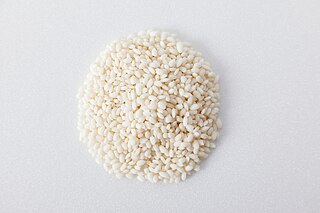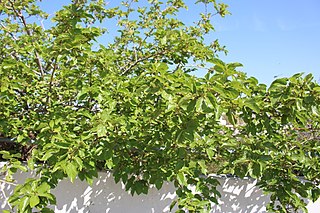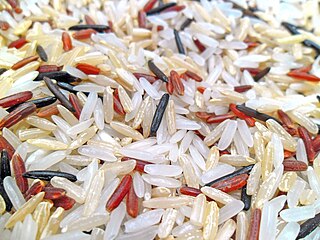 W
WActinidia deliciosa, the fuzzy kiwifruit, is a fruiting vine native to southern China, the fruit of which has been declared the national fruit of that country. Other species of Actinidia are also found in China and range east to Japan and north into southern areas of Russian Far East. This species grows naturally at altitudes between 600 and 2,000 m.
 W
WAllium chinense is an edible species of Allium, native to China, and cultivated in many other countries. Its close relatives include the onion, shallot, leek, chive, and garlic.
 W
WAmpelopsis grossedentata, commonly known as moyeam, is a species of plant in the family Vitaceae. It is mainly distributed in central and southern China, but can also be found in some southeast Asian countries. The leaves and stems are used to make a herbal tea called "moyeam". The product has been popular in China for generations and is now consumed in some other countries. The English name "moyeam" comes from the Chinese name "茅岩莓". Most moyeam is grown in Zhangjiajie, a mountainous region in Hunan Province in central China.
 W
WAn apricot is a fruit, or the tree that bears the fruit, of several species in the genus Prunus.
 W
WCastanea mollissima, also known as the Chinese chestnut, is a member of the family Fagaceae, and a species of chestnut native to China, Taiwan, and Korea.
 W
WDiospyros kaki, the Oriental persimmon, Chinese persimmon, Japanese persimmon or kaki persimmon, is the most widely cultivated species of the genus Diospyros. Although its first botanical description was not published until 1780, D. kaki is among the oldest cultivated plants, having been in use in China for more than 2000 years.
 W
WGlutinous rice is a type of rice grown mainly in Southeast and East Asia, Northeastern India and Bhutan which has opaque grains, very low amylose content, and is especially sticky when cooked. It is widely consumed across Asia.
 W
WGlycine soja, or wild soybean is an annual plant in the legume family. It is the closest living relative of soybean, an important crop.
 W
WJaponica rice, sometimes called sinica rice, is one of the two major domestic varieties of Asian rice varieties. Japonica rice is extensively cultivated and consumed in East Asia, whereas in most other regions indica rice is the dominant type of rice. Japonica rice originated from Central China, where it was first domesticated along the Yangtze River basin approximately 9,500 to 6,000 years ago.
 W
WMorus alba, known as white mulberry, common mulberry and silkworm mulberry, is a fast-growing, small to medium-sized mulberry tree which grows to 10–20 m (33–66 ft) tall. It is generally a short-lived tree with a lifespan comparable to that of humans, although there are some specimens known to be more than 250 years old. The species is native to central China and is widely cultivated and naturalized elsewhere.
 W
WMusa basjoo, known variously as Japanese banana, Japanese fibre banana or hardy banana, is a species of flowering plant belonging to the banana family Musaceae. It was previously thought to have originated in the Ryukyu islands of southern Japan, from where it was first described in cultivation, but is now known to have originated in subtropical southern China, where it is also widely cultivated, with wild populations found in Sichuan province.
 W
WThe orange is the fruit of various citrus species in the family Rutaceae ; it primarily refers to Citrus × sinensis, which is also called sweet orange, to distinguish it from the related Citrus × aurantium, referred to as bitter orange. The sweet orange reproduces asexually ; varieties of sweet orange arise through mutations.
 W
WThe peach is a deciduous tree native to the region of Northwest China between the Tarim Basin and the north slopes of the Kunlun Mountains, where it was first domesticated and cultivated. It bears edible juicy fruits with various characteristics, most called peaches and others, nectarines.
 W
WPrunus armeniaca is the most commonly cultivated apricot species. The native range & origination is in Armenia, as the name Prunus Armeniaca indicates. It is extensively cultivated in many countries outside of Armenia and has escaped into the wild in many places.
 W
WRice is the seed of the grass species Oryza sativa or less commonly Oryza glaberrima. The name wild rice is usually used for species of the genera Zizania and Porteresia, both wild and domesticated, although the term may also be used for primitive or uncultivated varieties of Oryza.
 W
WSiraitia grosvenorii, also known as monkfruit or luohan guo, is a herbaceous perennial vine of the gourd family, Cucurbitaceae. It is native to southern China and northern Thailand. The plant is cultivated for its fruit extract, called mogrosides, which create a sweetness sensation 250 times stronger than sucrose. Mogroside extract has been used as a low-calorie sweetener for drinks and in traditional Chinese medicine.
 W
WThe soybean, soy bean, or soya bean is a species of legume native to East Asia, widely grown for its edible bean, which has numerous uses.
 W
WTea is an aromatic beverage prepared by pouring hot or boiling water over cured or fresh leaves of Camellia sinensis, an evergreen shrub native to China and East Asia. After water, it is the most widely consumed drink in the world. There are many different types of tea; some, like Chinese greens and Darjeeling, have a cooling, slightly bitter, and astringent flavour, while others have vastly different profiles that include sweet, nutty, floral, or grassy notes. Tea has a stimulating effect in humans primarily due to its caffeine content.
 W
WMorus alba, known as white mulberry, common mulberry and silkworm mulberry, is a fast-growing, small to medium-sized mulberry tree which grows to 10–20 m (33–66 ft) tall. It is generally a short-lived tree with a lifespan comparable to that of humans, although there are some specimens known to be more than 250 years old. The species is native to central China and is widely cultivated and naturalized elsewhere.
 W
W